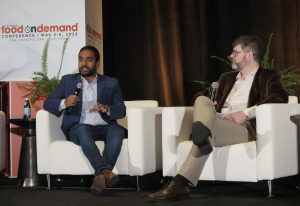Leaders from the third-party delivery industry shared insight on the state of the business during one-on-one conversations at the 2023 Food On Demand Conference.
Grubhub Chief Operating Officer Eric Ferguson and Uber Eats Head of Merchant Operations Yadavan Mahendraraj both joined Food on Demand Editor Tom Kaiser on stage Wednesday. In each of their conversations with Kaiser, the two discussed how their respective companies are responding to the evolving landscape.
“Restaurants are the backbone of this industry,” Ferguson said. “That being said, I think our diners are telling us that they want more delivery services. There’s people talking about groceries, alcohol and other things diners are asking us to do, so I think that’s going to be a change.
“I’ve seen that enterprise brands and even smaller restaurants are asking us to do more outside of Grubhub’s marketplace, like on their own websites,” said Ferguson. “I see that coming into play as well. I think we’re well positioned to see some of these new changes through and enter into new verticals.”

Editor Tom Kaiser (right) on stage with Yadavan Mahendraraj of Uber Eats during this year’s Third-Party Deep Dive.
During his time on stage, Mahendraraj shared how the increase in delivery is still developing, although some were ahead of the curve.
“The conversation two years ago was asking the question ‘is this going to continue?’ and ‘is delivery here to stay?’” Mahendraraj said. “Then a year ago, we said ‘delivery is here to stay.’ I think the people here in this room probably knew before that, because if you’ve come to a conference like this, you likely saw the importance of delivery.
“I think with the broader market, people were still trying to figure out that it’s here to stay, but about a year ago is when you really saw a momentum shift,” Mahendraraj said. “Businesses now are saying ‘this is going to be part of my process’ and are now asking ‘how do I incorporate this?’”
The response, Mahendraraj said, has been a major increase in tech companies and businesses considering what tech stacks they want to use, and what channels they want to provide to customers.
In Grubhub’s case, a valuable tech offering that restaurants can use is combining orders for more efficient delivery.
“It’s important to have efficiencies in our network,” Ferguson said. “We’ve heard other presenters talk about potential recession and lowering costs, things like that. Bundling is an important factor with that. So, if we have two customers in the same high rise ordering from the same McDonald’s it just makes a ton of sense to bundle those orders. Because of the size of our network, we have the ability to see optimization with bundles across restaurants.”
Mahendraraj also noted current economic headwinds, but said so far, people are still ordering delivery regularly.
“We are seeing prices go up, but we haven’t really seen major shifts,” Mahendraraj said. “There’s been a lot of questions on if we’re seeing people trading down, and the answer is ‘no.’ What we’re seeing is consumers looking for better value, and that’s what we see being a focus for us, that affordability. We know from focus groups that it’s really one of the things that customers are thinking about.”
To meet that demand, Mahendraraj said the company established Uber One, a membership program offering savings across Uber’s ride business and delivery business. The membership has been successful, Mahendraraj said, as many subscribers are utilizing the delivery option.
“In the U.S., 40 percent of orders are coming from subscribers,” Mahendraraj said. “We see significant growth there. There are some markets where we’re up to 65 percent. That’s also because of the frequency. The average Uber One user orders four times more than the average non-member.”


